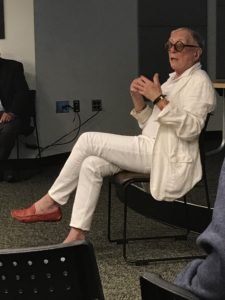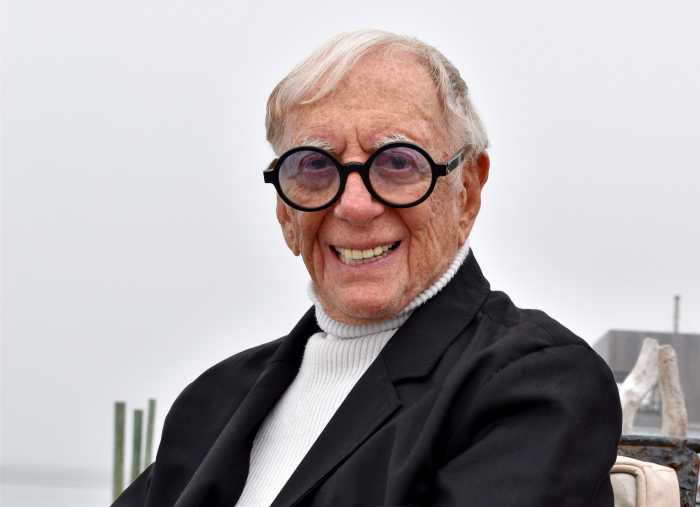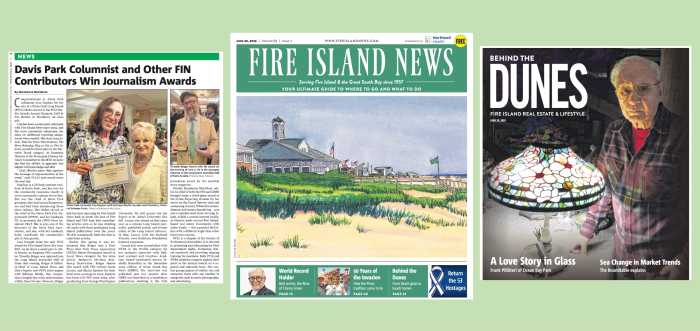By Danielle LipiecThis year’s Pride month kicked off with a presentation on Cherry Grove and Fire Island Pines at the Sayville Library on Thursday, June 7. “Sayville: Gateway to the LGBT Communities of the Pines & Cherry Grove,” a celebration of these unique communities and their relationship with the town of Sayville, was led by guest speaker, Bob “Rose” Levine. As one of Cherry Grove’s longtime residents, Fire Island News’ Cherry Grove and Pines columnist, and this year’s Cherry Grove Homecoming Queen, Levine spoke with ease as he relived his 64 years on the island. The presentation on the gradual social reform of the two communities and the pleasant times that came with them drew Fire Island and Sayville residents alike.With a Cherry Grove ferry station in Sayville and organizations such as the Islanders’ Club bus service, which provided a private means of safe and comfortable transport for LGBT people, many Sayville residents and members of other parts of Long Island sought the essence of inclusivity that Cherry Grove and the Pines offered. As the masses migrated to the island, Levine described watching hotels, restaurants and clubs like the Belvedere, Pavilion, and Ice Palace phase in and out of ownership, as businesses adapted to the growing and changing population. “I came to Fire Island in 1955, and I bought my house in 1965. I’ve been coming here 64 years, and still feel the same,” said Levine. “I was one of the first gay men to buy a house. Most of the people who owned houses there were married couples from Sayville. At that time it was a little fishing village, and they had friends from the theater who would visit,” Levine recalled. These visitors eventually began migrating to the island themselves, bringing with them their own friends, who happened to be a predominantly gay crowd.Levine’s presentation focused not only on good times, but also on the struggles faced while these evolving societies experienced social change at a swift pace. As the population of the Grove and Pines grew and changed in demographic, so did businesses and social order. Where Duffy’s Hotel stood until 1956, the infamous Ice Palace was built, and gay residents of Cherry Grove flocked there. “If you danced together, you had to have two women and a man, otherwise you could get arrested. Policemen were watching,” said Levine. And so line dancing popularized in island clubs. Dances such as The Madison became all the rage, as it allowed members of the same sex to dance together as long as at least one member of the opposite sex was involved. The Ice Palace has come far since, as Levine and audience members described the club’s drag shows and Friday night underwear parties.Progress in the fight for rights for the LGBT community on Fire Island did not cease at line dancing. Levine colored a vivid image of the very first Invasion of the Pines as a member of the event. He told the story of how well known Pines restaurant owner, John Whyte, denied service to visitor Terry Warren, who was dressed in drag. After being asked to leave, Warren informed Panzi, Cherry Grove’s 1976 Homecoming Queen, of the incident. “A week later, Panzi organized a group, and we had a water taxi with about 15 people,” said Levine. “We came into the Pines, they were tooting the horns, and John Whyte welcomed us.” This would not be the last time a group of drag queens proudly came to the Pines on a boat, as the tradition of The Invasion has continued every year since its first occurrence. “We had first water taxis, then chartered ferries, and now we need two of them,” Levine said. “Now its one of the most famous events on Fire Island, and it keeps getting better.”The social evolution of Cherry Grove and the Pines has led to a number of organizations working for the LGBT residents of Fire Island. From Senior Action in a Gay Environment (SAGE), to Lambda Legal, to God’s Love We Deliver, a number of charity organizations have made their way to Fire Island to assist people in need.By the end of the talk, the room had laughed and remembered together, and a sense of nostalgia was evident among the attendees. The jovial atmosphere of the presentation room reflected the happy times and social progress of these island communities, and how residents like Levine contributed to both.
As the masses migrated to the island, Levine described watching hotels, restaurants and clubs like the Belvedere, Pavilion, and Ice Palace phase in and out of ownership, as businesses adapted to the growing and changing population. “I came to Fire Island in 1955, and I bought my house in 1965. I’ve been coming here 64 years, and still feel the same,” said Levine. “I was one of the first gay men to buy a house. Most of the people who owned houses there were married couples from Sayville. At that time it was a little fishing village, and they had friends from the theater who would visit,” Levine recalled. These visitors eventually began migrating to the island themselves, bringing with them their own friends, who happened to be a predominantly gay crowd.Levine’s presentation focused not only on good times, but also on the struggles faced while these evolving societies experienced social change at a swift pace. As the population of the Grove and Pines grew and changed in demographic, so did businesses and social order. Where Duffy’s Hotel stood until 1956, the infamous Ice Palace was built, and gay residents of Cherry Grove flocked there. “If you danced together, you had to have two women and a man, otherwise you could get arrested. Policemen were watching,” said Levine. And so line dancing popularized in island clubs. Dances such as The Madison became all the rage, as it allowed members of the same sex to dance together as long as at least one member of the opposite sex was involved. The Ice Palace has come far since, as Levine and audience members described the club’s drag shows and Friday night underwear parties.Progress in the fight for rights for the LGBT community on Fire Island did not cease at line dancing. Levine colored a vivid image of the very first Invasion of the Pines as a member of the event. He told the story of how well known Pines restaurant owner, John Whyte, denied service to visitor Terry Warren, who was dressed in drag. After being asked to leave, Warren informed Panzi, Cherry Grove’s 1976 Homecoming Queen, of the incident. “A week later, Panzi organized a group, and we had a water taxi with about 15 people,” said Levine. “We came into the Pines, they were tooting the horns, and John Whyte welcomed us.” This would not be the last time a group of drag queens proudly came to the Pines on a boat, as the tradition of The Invasion has continued every year since its first occurrence. “We had first water taxis, then chartered ferries, and now we need two of them,” Levine said. “Now its one of the most famous events on Fire Island, and it keeps getting better.”The social evolution of Cherry Grove and the Pines has led to a number of organizations working for the LGBT residents of Fire Island. From Senior Action in a Gay Environment (SAGE), to Lambda Legal, to God’s Love We Deliver, a number of charity organizations have made their way to Fire Island to assist people in need.By the end of the talk, the room had laughed and remembered together, and a sense of nostalgia was evident among the attendees. The jovial atmosphere of the presentation room reflected the happy times and social progress of these island communities, and how residents like Levine contributed to both.




























